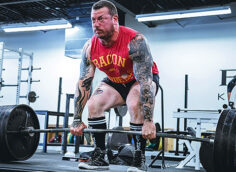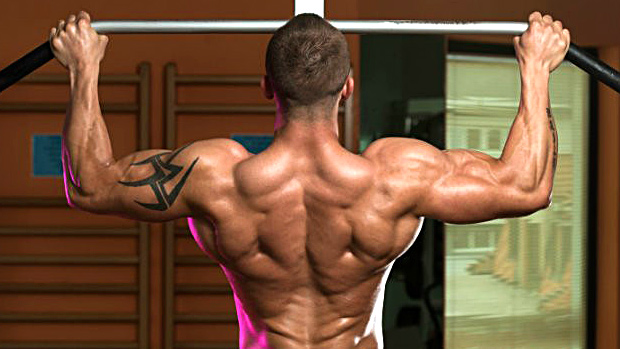Shoulder Training: The Final Word?
Q: Some coaches say there's no need for direct shoulder training because the delts are hit with other exercises. They say to do a few lateral raises and that's it. Others recommend full delt specialization workouts. What do you think?
A: I was one of the first to say that you don't really need direct shoulder work. I've been saying that for twenty years. But there are some exceptions, especially for cosmetic reasons.
If a guy has shoulders like pancakes, then I'd prescribe direct shoulder work. In fact, for bodybuilding purposes, it's fairly hard to get to the top without direct shoulder work.
The anterior and posterior deltoids usually do get enough work if you do chins, rows, bench press, dips, etc. But a lot of people neglect their back, so their posterior deltoids can be lacking.
What I find works best for shoulder hypertrophy is tri-sets. The shoulders have intermediate-type fibers. They respond best to multiple exercises with short rest intervals, eight to ten reps, varying the motor resistance. For example, here's a quick fix for lagging shoulders:
- A1. Seated Lateral Raise, 6 to 8 reps, 10 seconds rest
- A2. Machine Lateral Raise, 10 to 12 reps, 10 seconds rest
- A3. Double Cable Lateral Raise (single pictured below), 15 to 20 reps, 120 seconds rest, then start cycle over with A1



Now, the medial deltoid does seem to be the "missed" deltoid, but it's a myth that there are only three deltoids (posterior, medial, and anterior). French anatomists showed several years ago that there are actually seven portions of the deltoid you can selectively activate. That's why when you look at the sporting world, the best shoulder development is seen in gymnasts – they apply force at every angle you can think of!
Now, the shoulders actually recover very quickly. The delts are slow-twitch, so recovery can be fast. Frequency is important here. If you have a lack of shoulder development, you may need to train delts three days per week.
All Muscle, No "Bulk Belly"
Q: Is it necessary to gain fat in order to gain muscle? And can you lose fat and gain muscle at the same time?
A: It's not necessary to gain body fat when trying to add muscle mass. That's an antiquated idea. It's one of the dumbest things I see – guys eating candy bars and fast food when trying to build muscle.
The problem in the weight training world is that people don't give a shit about good health. I see weight training as being a lifelong activity. The cleaner you eat the better. Bill Pearl and Dave Draper are still lifting weights.

It's quite possible to gain muscle while losing fat. I've seen it hundreds of times with my athletes. I have a kid from the University of Southern California who was 25% body fat. I got him down to 12% in eight weeks, and he gained 25 pounds of muscle.
Now, a cheat day every five to seven days (depending on your metabolism) is okay when you're trying to gain muscle. I think it's hard to put muscle on when eating clean all the time. But there's a difference between a cheat day every fifth day and eating crap at every meal.
Even on cheat days however, I tell my athletes to avoid trans-fats, which can do severe damage to the body. I'd rather see a skinny guy who's trying to gain muscle wolf down a bunch of rice pudding than eat French fries.
BCAA, Pam Anderson, and the Dominican Republic
Q: Is there a supplement-related trick to retaining muscle while on a strict fat loss program?
A: Not only can you retain muscle while losing fat, but as I talked about in the previous question, you can gain muscle. In fact, you should gain muscle if you know how to train and eat properly!
One thing to remember: If you're on a fat loss diet, you must be consuming a lot of good dietary fats. A lot of guys who don't retain muscle when dieting are basically eating too lean – egg whites and chicken breasts all day long. You need to add quality fats, and I'm not talking about a burger from McDonalds.
Dr. Mauro DiPasquale taught me a long time ago that when you go low carb to lose body fat, you still need to take in a lot of dietary fat or you won't have any success. We're talking about smart fats here like omega-3s, which can battle inflammation. You have to realize that our DNA has only evolved about .02% in the last forty thousand years, and the meat our caveman ancestors ate had much more omega-3 than the meat we eat now.
I realize how anabolic food is every time I go teach in the Dominican Republic. Last time I taught a Biosignature Modulation course in the DR, the students took my body fat Monday morning. I was at 8% and weighed 198 pounds.
Now, there's no such thing as grain-fed in the DR; they can't afford it, so cows eat grass. And if you eat a mango over there you have to eat it over a sink because it's so juicy. The eggs too are far more anabolic. They're orange and full of omega-3s, like all eggs naturally were thousands of years ago.
A DR avocado tastes like butter it's so rich in nutrients. Eating avocados over here is like eating fiberglass once you've had a DR avocado. It's like having sex with Pamela Anderson then having to have sex with Rosie O'Donnell.
Anyway, five days later, after eating only Dominican Republic foods, I weighed 209 at 6% body fat. My business partner came to finish the seminar, took one look at me and said, "What happened to you?!"
But when I work in the UK or Ireland, I lose muscle mass and put fat on almost inevitably, even though I try to eat as cleanly as possible. The quality of the food is just piss poor.
Back to your question. One of the most important supplements to take when on a calorie restricted diet is BCAAs. You need about 50 grams a day. Take it between meals.
Incredible, Edible, and Anabolic?
Q: Are whole eggs okay or should I stick to only egg whites?
A: Only dorks eat egg whites. You see these diets in the muscle magazines; they always list egg whites and oatmeal for their bullshit breakfasts. Well, if you took four Sustanons between every meal and seventeen Anadrols per hour, well, you could eat anything you wanted!
A guy training naturally needs whole eggs. What about the reported health concerns? Well, the studies that showed eating eggs raised cholesterol were done by the cereal board. And back then they didn't differentiate between the types of cholesterol, so the studies were invalid. Eggs can raise cholesterol – HDL, the good cholesterol.
The only caveat with eggs is that you can become allergic to them if you eat two or three every day. I saw this when I used to run a lot of food allergy tests. Stop eating eggs for six weeks and the allergy will disappear, then you can eat twelve every five days. Hey, if you're going to have them, don't be a pansy.
Carbs, Hot Asians, and Oatmeal
Q: My Asian girlfriend eats all the carbs she wants and still has abs. I can eat too much healthy oatmeal and lose my abs in a heartbeat! What gives? Is this really a genetic or ethnic heritage difference?
A: Two things here. First, Asians are part of the 25% of the world population that are carbohydrate adapted. Provided they're plain carbs, they can eat them and still remain lean.
Asians can tolerate carbs more because their culture has had agriculture longer than other cultures; they're adapted. (On that same note, perhaps soy is bad for Caucasians but not so bad for Asians. Think about it.) But, most Asians can't tolerate diary. It just hasn't been around long in their diets.
Second, you're not Asian, and oatmeal is the most common food allergen. It comes from the grass family after all.
In 2001 I ran blood work on every single one of my clients using six different labs. Oatmeal always came out as the most frequent food allergen. It can raise cortisol and lead to the storage of fat in the abdominal area.
I'm anti-oatmeal, especially for Caucasians. Quinoa may be a better choice.
Recruit More Motor Units
Q: It's been theorized that training a muscle where the exercise provides a good stretch (such as incline biceps curls) leads to greater hypertrophy. Is that true?
A: No. Well, it canlead to hypertrophy of course, but for a different reason. It's like with my isometronic biceps routine where you use isometrics by pushing or pulling a bar in a rack. It develops hypertrophy, but for a different reason than traditional lifting develops hypertrophy.
People are too dogmatic. An exercise is only as good as the time it takes you to adapt to it. Provided you use enough load for enough time, all exercises can build muscle. It's just that some are better at it than others. It has to do with what German strength physiologists call the Scale of Motor Unit Recruitment.
For example, cam exercises for a given number of reps recruit less motor units than a pulley exercise. And that pulley exercise recruits less motor units than a dumbbell exercise. The more you stick to what we were designed for as animals – lifting rocks, carrying carcasses, and generally just fighting against gravity – then the better off you are. What that means is using free weights over machines.
Now, some people argue that every exercise should be done standing if possible. But if you look at research on motor unit recruitment, the fewer muscles you involve in other parts of the body, the better.
For example, there's more motor unit recruitment in incline curls and Scott curls than standing curls. When you stand and curl, your whole posture changes so you don't fall. When you're seated doing curls you can send all your neural drive to those motor units and get better recruitment.
EMG studies at the University of York showed that the more you can isolate the exercise with a free weight (in a single-joint movement) the more motor units are recruited. Now if you measure motor unit recruitment in the quadriceps on a leg extension vs. a squat for a given number of reps, you'll always get more motor unit recruitment in the squat. But when we're talking about single-joint exercises, the more you can isolate your neural drive for the targeted muscle, the better recruitment you'll get. So, Scott curls will recruit more motor units in the elbow flexors than standing barbell curls.
Eliciting survival fibers will cause you to recruit more motor units as well. If you do a split jerk, there's additional recruitment of the triceps because if there wasn't you'd drop the bar on your head. The snatch or power snatch will recruit more motor units than the power clean because there's more risk with those exercises. Risk equals more motor unit recruitment.
There are actually seven levels of muscle activation. One of the keys in strength training is to choose the right exercise, what I refer to as the "most bang for your buck" exercise. Here's a modification of Dietmar Schmidtbleicher's chart on levels of activation. My Swedish colleague Riccard Nillson and I added the seventh level. You should devote your training to mostly level five and above exercises:
Compound vs. Isolation Exercises
Neuromuscular Activity – NMA
- Isolation exercise on variable resistance machine, i.e. leg extension on cam type machine: Cybex leg extension, DAVID leg curl
- Complex exercise on variable resistance machine, i.e. leg press on Nautilus machine, LifeFitness incline press machine
- Isolation exercise with constant resistance machine, i.e. Scott pulley curls, triceps pressdown on pulley machine
- Complex exercise with constant resistance machine, i.e. leg press on standard machine
- Isolation exercise with free weights, i.e. Scott barbell curls, lying flyes
- Complex exercise with free weights, i.e. snatch pulls, power cleans
- Complex exercise with free weights, i.e. power snatch, dips on rings, rope climbing, split jerks

Another Dumb "Advanced" Exercise
Q: Got any new observations on dumb exercises you've seen promoted in the strength training community?
A: A consistent problem I've seen in budding strength coaches is that they're so preoccupied with being original that they invent the dumbest exercises. One of the dumbest fucking "innovations" I've seen on record is the seated good morning where the trainee holds the bar in front of himself while completing the exercise. Here's a proper seated good morning (bar on back):

But this "innovative" trainer decided that the bar should be held in front of the body. Here's the story: Recently, a very qualified colleague of mine, a former Mr. Universe winner, a PICP level three with over 20 years experience in the field, designed a lower back rehab program. It required that the client complete a seated good morning to commence with their rehabilitation. This was an excellent choice, as it allows the trainee to build up the erector spinae without compromising the spinal structure.
My colleague had to leave his gym for a week to attend the Biosignature Level 2 in Scottsdale, Arizona. As a result, he asked one of his employees to demonstrate the program for the client. Unfortunately, this dimwitted employee, wanting to show off to the client, said that it would be better to do the seated good mornings holding the bar on the clavicles, as it would be "safer" on the shoulders.
What kind of moron comes up with that one? Someone with very poor understanding of physics, that's for sure.
This approach begs many questions. What about the effects of gravity when the torso comes parallel to the floor? What kind of strain occurs on the rhomboids and rotator cuff while struggling to retain the bar on the clavicles?
My colleague's blood pressure was going through the roof as he was relating the story to a bunch of coaches over dinner. I was laughing so hard I had to put manual pressure on my spleen so it wouldn't rupture. All of us present at dinner emphatically recommended that our friend sack his employee immediately upon his return. God forbid that he should recommend lean-away squats on the Bosu ball.
Some of these coaches really think they're on to something, too. They act like they've discovered a new planet that's going to be named after them. Listen, eccentric training and fat-bar training were first discussed in 1908! I own a fairly extensive library in multiple languages on strength training, and frankly, there's nothing much new under the sun.
The Truth About Bar Speed
Q: I've read recently that you should end the set when the bar speed slows down. True?
A: That fucking kills me. It's just plain stupid.
Name me one athlete who's set a world record doing that. Go to any international training hall and see the Bulgarians, Turks, Ukrainians, etc. train. Watch them do front squats for sets of three. Their spleens shoot through their left eyes on the last rep. Is the bar going slow? Yeah, it is. Is the intent to go fast? Certainly. Intent and velocity aren't the same thing.
Go back in time and implement this stupid idea in the weightrooms across the world. You know what you'd see today? A world record bench press of 135 pounds.
Stress Reduction for Real Men
Q: Everyone talks about reducing stress to remain healthy. Got any practical tips for actually doing that?
A: The first thing to do to relieve world levels of stress is shoot all lawyers. But on a more practical note, I found some interesting things about this when I recently consulted a professional English soccer team.
It turned out that when they played a game on Saturday it took them until Wednesday for their sleep patterns to return to normal. In other words, they're jet lagged once per week, even when playing at home!
I told the athletes that when they go back to their hotel rooms they should unplug everything – TV, alarm clock, etc., and turn off their cell phones. Get rid of the electrical magnetic fields. Then make the room as dark as possible and wear an eye mask. The next day I thought the guys were going to kiss me. They said it was the first time they felt they'd really slept.
We're designed to live in caves. It should be pitch dark. And cell phones emit radiation. Get rid of these things and you'll reduce stress and sleep better. Making your bedroom the Bat Cave alone will increase the amount of melatonin and GH you produce when you're asleep. That alone will make you grow.
Another thing to do to relieve stress is to take a time management course. I only answer emails twice per day for example. There are many small things like this that can really add up to reduce stress, and that's important. The best time management course out there can be found on www.missioncontrol.com.
We experience one hundred times more stress than our grandfathers. Stress accounts for as much as 90% of all primary care physician visits. With anxiety disorders, insomnia, depression, ulcers, etc., each affecting millions of Americans, stress and its effects could be considered an epidemic.
Stress increases heart disease, diabetes, mental disorders, sexual dysfunction, and gastrointestinal disorders. It suppresses the immune system and lowers Testosterone. Stress can lead to muscle loss and fat gain.
Everyone is under stress. This is the norm, not the exception. As a result, our bodies tend to run on adrenalin and cortisol. That can be great if you're being chased by a lion or a linebacker, but not so useful if you're just going about your daily activities.
So, take actions to control stress. Improving sleep and learning time management are the first steps.
Melatonin... Between Your Legs
Q: What do you think of supplemental melatonin for sleep?
A: It's often warranted for people after the age of 31. You don't need a high dose, about 3 mg, and the best way to take it is through cream form. You rub it inside your thighs where your skin in thin. Because it doesn't come out of a bolus in your GI tract, you won't wake up groggy.
I take it oversees with me and people wonder why I don't have jetlag. Well, the first night I'm there I stay up as late as I can, then I put on the melatonin cream. No jetlag.
Another thing that's good for natural melatonin production is to dim the lights after dark. Starting as soon as the sun goes down, dim the lights or don't have lights on in the house as you're watching TV. Your body will naturally make more melatonin in the darkness.
By the way, know why men are compelled to channel surf? It's in our genetic code. We were programmed by watching the constantly flickering fire outside of the cave. Tell your wife or girlfriend that the next time you're driving her nuts flipping through the channels!
New Supplement Excitement
Q: Any new supplement or area of supplementation that has you excited right now?
A: Anything that helps support acetylcholine production by blocking the acetylcholinesterase enzyme is great for older athletes. Huperzine, for example, contained in a product I make called Fast Brain, helps you regain strength lost due to aging.
People get boners looking at the muscle physiology, but they forget what actually drives the muscle. So anything that has to do with eliciting more motor units is even more interesting. No use spending your time only on the motor if you don't get the transmission right!





